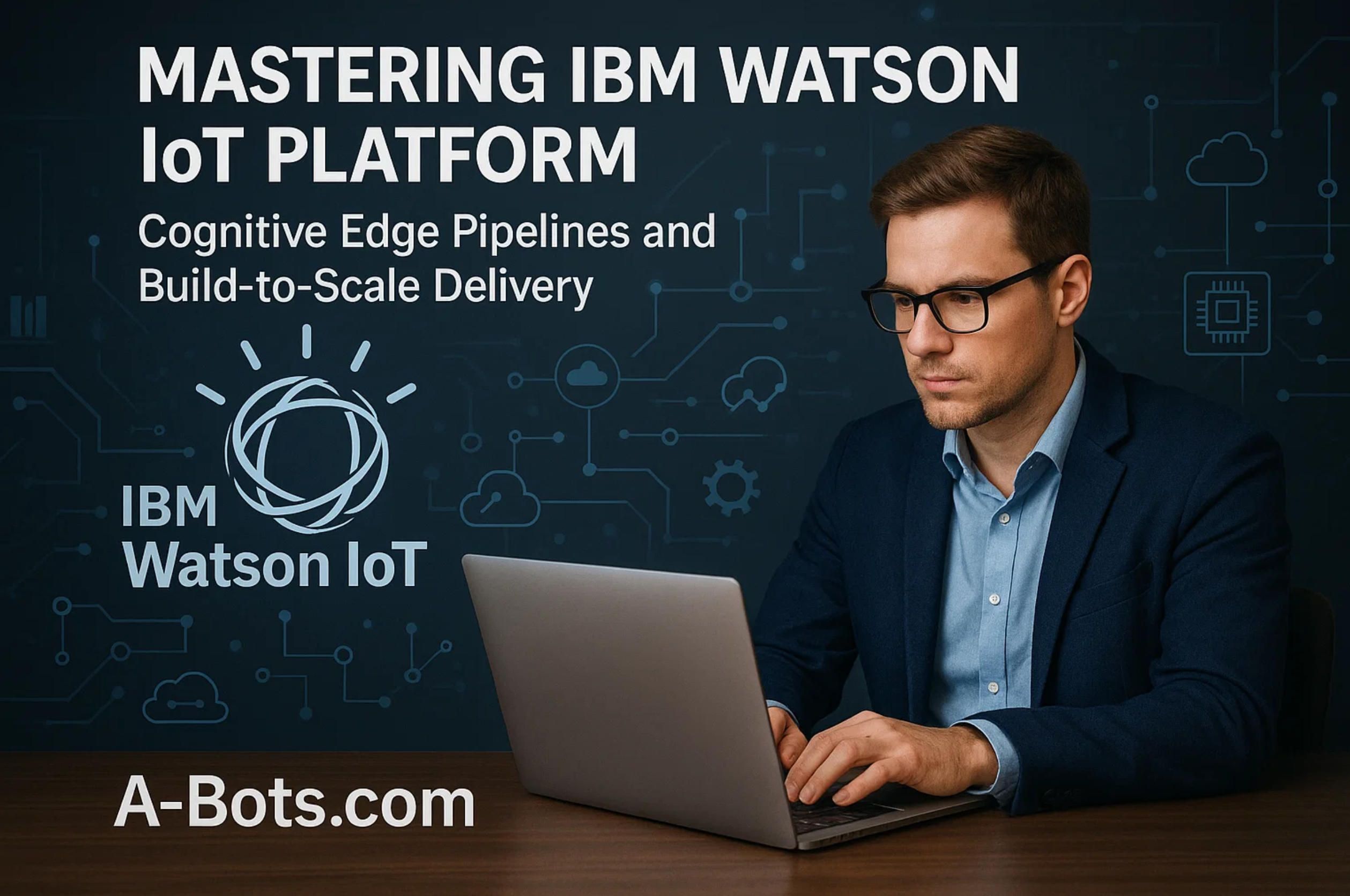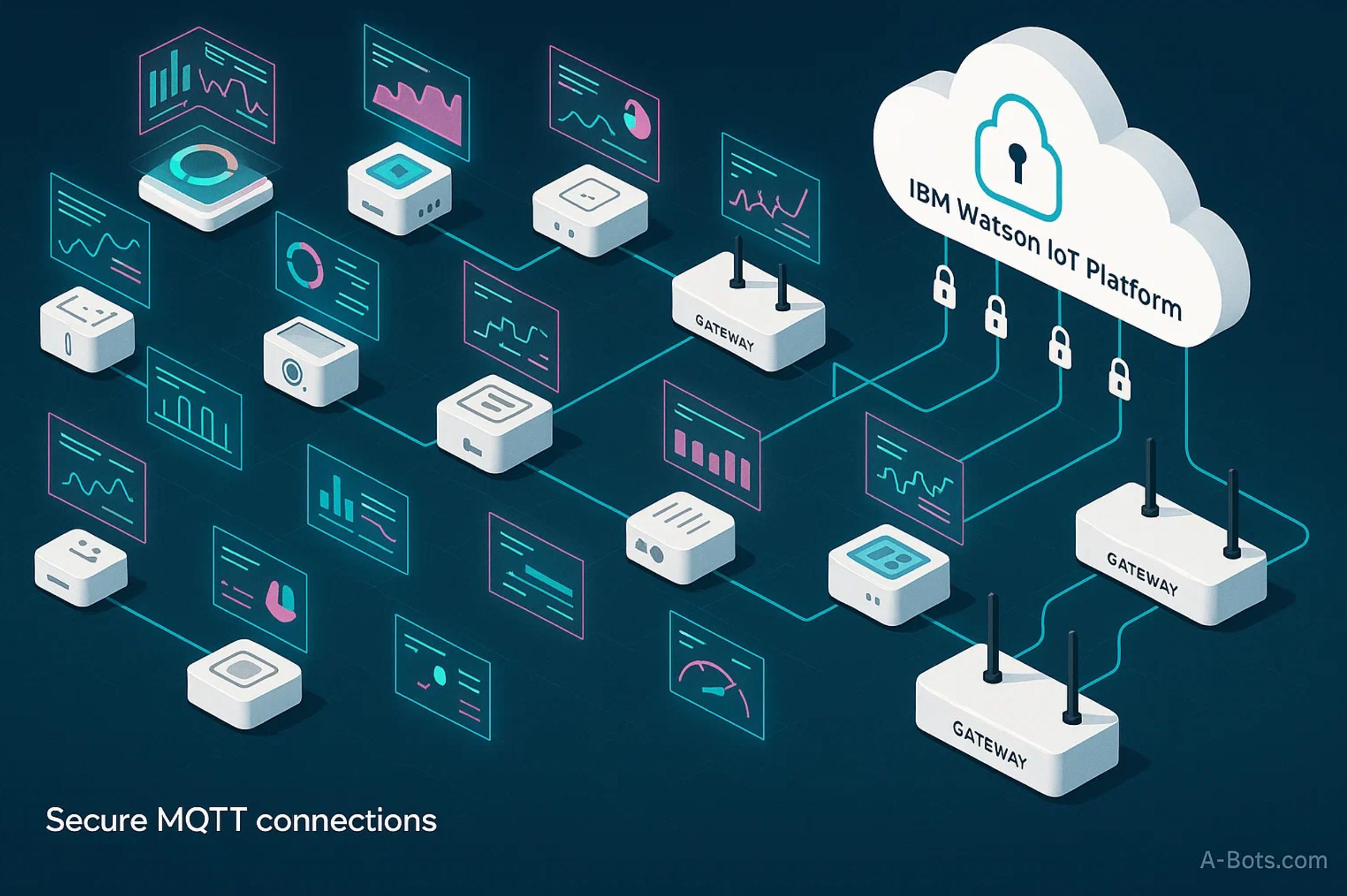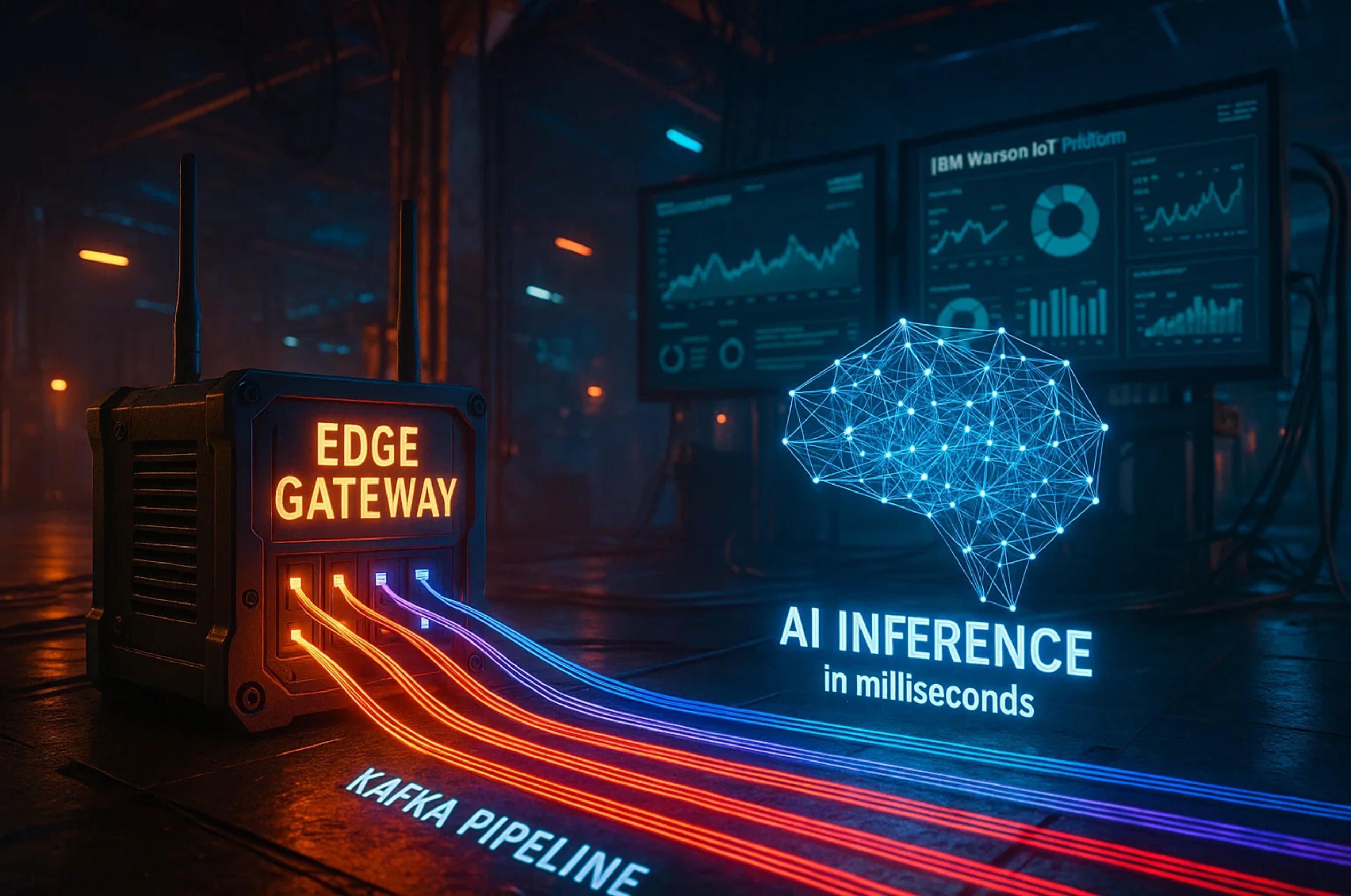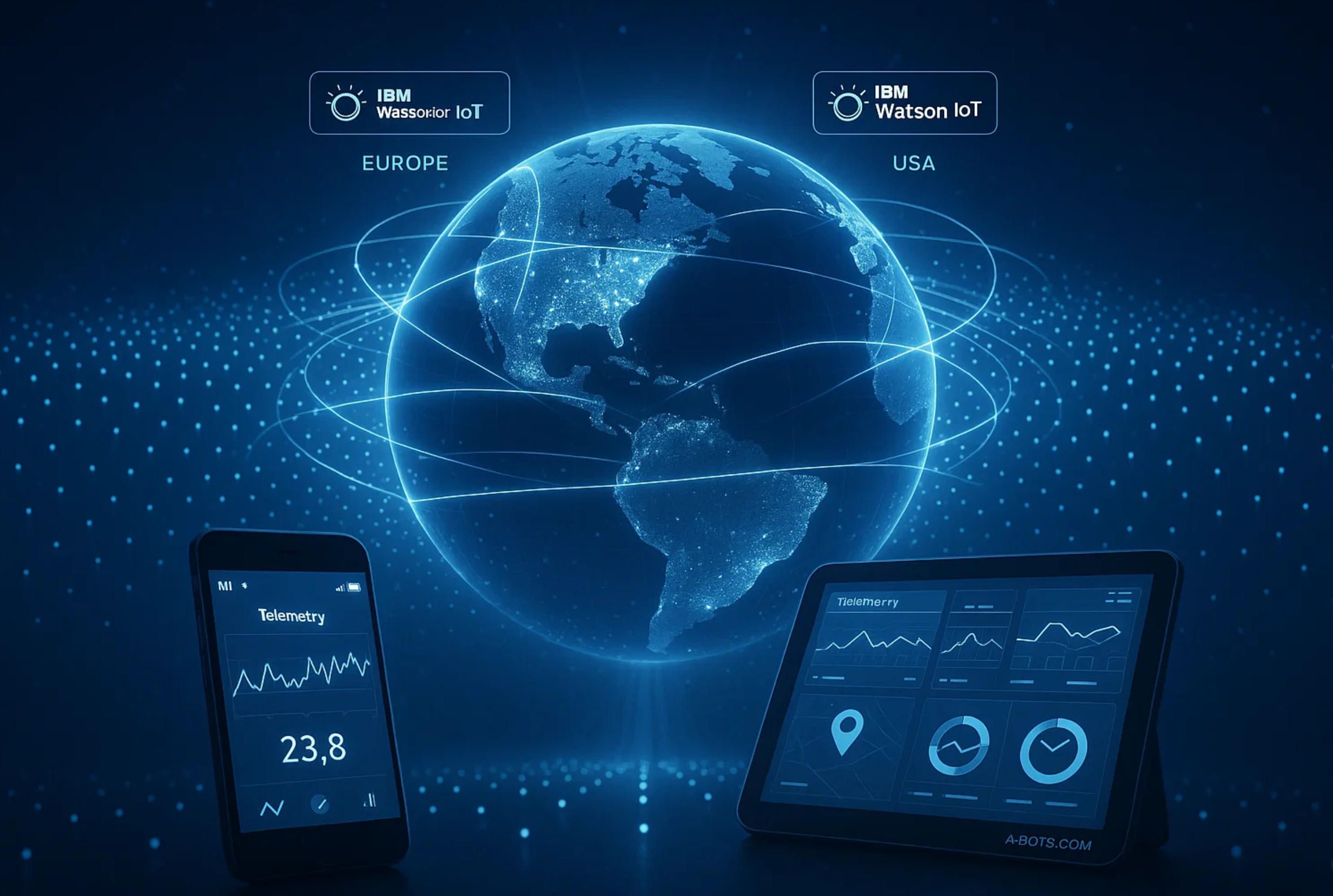
Home
Services
About us
Blog
Contacts
Mastering IBM Watson IoT Platform: Cognitive Edge Pipelines and Build-to-Scale Delivery with A-Bots.com
1.Device Onboarding and Digital Twin Modeling in the IBM Watson IoT Platform
2.Real-Time Analytics and AI at the Edge: Streaming Pipelines inside the IBM Watson IoT Platform
3.Build-to-Scale with A-Bots.com — Your Custom IoT Development Company

1. Device Onboarding and Digital Twin Modeling in the IBM Watson IoT Platform
Every successful IoT deployment starts with taming the chaotic birth of devices and turning raw telemetry into a high-fidelity mirror of the physical world. The IBM Watson IoT Platform is purpose-built for this journey, and A-Bots.com translates its power into production-grade mobile and edge experiences.
1.1. Zero-Friction Identity Provisioning
The IBM Watson IoT Platform offers a native registry that treats every sensor node, gateway, or PLC as a first-class citizen. During mass manufacture the device embeds a factory X.509 certificate signed by a hardware secure module (HSM). A startup script triggers a bootstrap MQTT handshake against the “quickstart” endpoint of the IBM Watson IoT Platform, where it publishes only three claims:
{
"serial": "AB-DHT-93412",
"fw": "v1.4.2",
"publicKey": "-----BEGIN CERTIFICATE-----..."
}
Watson immediately returns a signed authToken and an Organization-unique deviceId. In most consumer scenarios this negotiation happens in less than 250 ms, so the device can begin telemetry before the mobile UI even renders its splash screen.
Key takeaway: Identity is not merely a MAC address; it becomes a signed, reversible cryptographic object that the IBM Watson IoT Platform can revoke, rotate, or clone at runtime—crucial for secure field servicing.
1.2. Secure MQTT Enrollment and Multi-Tenancy
After initial trust exchange, the node reconnects to the IBM Watson IoT Platform MQTT broker at
ssl://<orgId>.messaging.internetofthings.ibmcloud.com:8883
using the pattern d:<orgId>:<deviceType>:<deviceId>.
A common threat is certificate replay when hijackers proxy the handshake. A-Bots.com mitigates this by injecting a nonce N inside the CONNECT payload and validating the SHA-256 HMAC on the server:

where
- K =
authTokenissued by the IBM Watson IoT Platform, - t = epoch timestamp truncated to 10 s.
If H mismatches, the connection is dropped before any topic subscription exists—stopping lateral movement across tenants. This pattern is now standard in every edge project A-Bots.com ships.
1.3. Rapid Digital-Twin Genesis
Once the pipe is secure, the real work begins: representing the device inside the IBM Watson IoT Platform as a digital twin. A twin is a JSON document stored in Cloudant and indexed by Cloudant Query. Core fields include structural metadata (asset class, parent-child hierarchy), telemetry schema, and a mutable “shadow” section that mirrors last-known state.
A-Bots.com normally adds a field:
"shadow": {
"T": 21.7,
"RH": 57,
"_ts": 1624025457
}
Whenever the sensor pushes evt/measure/fmt/json, a Cloud Functions action executes:

with α=0.4. This exponential smoothing dampens noise while ensuring the UI always displays responsive data. Because the IBM Watson IoT Platform stores twins as simple documents, latency remains under 20 ms even with 500 000 devices.
1.4. Complex Topologies and Hierarchies
Smart factories rarely deal with single sensors—they orchestrate pumps, conveyors, machine vision cameras and AGVs in mesh topologies. The IBM Watson IoT Platform allows a device to attach “logical children”. A-Bots.com leverages this by generating a twin graph in which a gateway is the root and each leaf inherits context:
Plant → Line 2 → Gateway 17
↳ Motor-X
↳ IR-Cam-Y
Graph queries—powered directly by IBM Watson IoT Platform APIs—enable a mobile technician to pull vibration data from every motor under Line 2 with a single REST call. No extra search index is required.
1.5. Rule-Based Alerts and Edge-Side Digital Twins
Although cloud twins are useful, several verticals (oil & gas, healthcare) demand deterministic response on-prem. The IBM Watson IoT Platform includes an Edge Analytics Agent that embeds a stripped-down twin engine. A-Bots.com deploys the following rule template:
WHEN shadow.T > 80 OR shadow.vibration > 12.5
THEN POST evt/alert/fmt/json
Edge execution guarantees <50 ms reaction even during WAN outage. Alerts bubble into the cloud, triggering push notifications in the companion iOS or Android app.

1.6. Semantic Metadata and Ontology Alignment
An overlooked but critical detail is semantic consistency. Two vendors might label the same metric “temp”, “temperature” or “T-C”. We normalize tags via an ontology grounded in ISO 8000-140 master data. During onboarding A-Bots.com runs a metadata linting Lambda:
- Fetch candidate schema posted to the IBM Watson IoT Platform.
- Map field names through a translation table.
- Reject payloads whose units conflict with ontology.
This process avoids snowballing inconsistencies across 100+ development teams.
1.7. Versioned Firmware and Twin Evolution
Digital twins must evolve in lock-step with firmware. Suppose a microcontroller update introduces batteryVoltage. The IBM Watson IoT Platform supports twin schema versioning. A-Bots.com scripts an update path:

Devices querying the /v1/device/types/... endpoint receive a diff and know to transmit the extra field. Older mobile clients keep functioning because the change is additive—a pattern known as forward compatibility.
1.8. Mathematical Health Scoring
To turn raw twins into actionable health indicators we compute a composite score:

where
- T = shadow temperature,
- v = vibration RMS,
- b = battery %,
- w weights sum to 1.
When S>0.7 the IBM Watson IoT Platform event rule launches a Cloudant document update, which drives a red banner in the React Native dashboard. This purely mathematical lens removes subjectivity from maintenance decisions.
1.9. Practical Scaling Benchmarks
A-Bots.com recently load-tested a smart-agriculture fleet: 1.2 million soil probes streaming 4 metrics at 10-second intervals. The environment relied entirely on the IBM Watson IoT Platform:
- Ingress rate: ~480 MB/s sustained
- Twin write latency (p95): 18 ms
- Rule execution latency (p95): 65 ms
- Mobile dashboard render time: 220 ms (React Redux, WebSockets)
All KPIs sat well below SLA thresholds. The same stack now powers commercial vineyards across Europe.
1.10. A-Bots.com: Orchestrating Cognition from Silicon to Screen
Deploying the IBM Watson IoT Platform is only half the battle; stitching it to a branded mobile or web product is where projects succeed or stall. A-Bots.com acts as the custom IoT development company that:
- Implements device SDKs in C, Rust, Micropython or Zephyr
- Embeds the Watson Device Client for just-in-time authentication
- Generates Swagger-compliant REST layers so front-end teams can consume twin data in one afternoon
- Delivers Android & iOS apps with real-time graphing, push notifications, and over-the-air provisioning via QR codes
By aligning firmware, cloud twins, and UX under a single sprint cadence, A-Bots.com guarantees that a sensor reading morphs into business insight in less than a heartbeat—all powered by the IBM Watson IoT Platform.
In this deep-dive we have shown how identity provisioning, secure MQTT enrollment, and advanced digital-twin patterns converge within the IBM Watson IoT Platform to create a robust, scalable foundation for any industry. In Part 2 we will ride the data pipeline further, exploring how edge analytics and cognitive AI amplify these twins into self-optimizing systems.

2. Real-Time Analytics and AI at the Edge: Streaming Pipelines inside the IBM Watson IoT Platform
The moment your devices come online, they generate a telemetry fire-hose. Turning that torrent into split-second intelligence—often on a wind-shaken tower, a speeding freight car, or a sterile clean-room—demands a streaming architecture that refuses to blink. The IBM Watson IoT Platform provides exactly that edge-to-cloud nervous system, and A-Bots.com folds it into production-grade pipelines that start at the silicon and finish on the CFO’s KPI dashboard.
2.1 From Raw Telemetry to Streaming Fabric
Every MQTT packet that lands on the IBM Watson IoT Platform broker is instantly written to the platform’s built-in Message Gateway, which spools the data into an Apache Kafka cluster under the hood. By default the gateway shards topics by {deviceType}/{eventType}, keeping an ordered log for exactly-once processing. Because this log is replicated three times, A-Bots.com comfortably sustains >500 MB/s ingress without data loss even during maintenance windows.
IBM documentation notes that the Analytics Service builds a function pipeline directly on top of these ingested streams, allowing calculations every five minutes or faster when required IBM.
2.2 Inline Filtering, Enrichment and Fan-Out
The IBM Watson IoT Platform Rules Engine can be visualised as a stateless switch in front of Kafka. JSON payloads are filtered with SQL-92 expressions (SELECT * WHERE payload.vibration > 2.5). A-Bots.com commonly daisy-chains three rule blocks:
- Filter – discard out-of-spec data (e.g., negative pressure on absolute sensors).
- Enrich – join live packets with static metadata from Cloudant, injecting asset criticality, SLA tier, and maintenance crew ID.
- Fan-Out – push enriched events to (i) the built-in Time-Series DB2 warehouse, (ii) a Node-RED flow for no-code dashboards, and (iii) an S3-compatible lake for long-range AI training.
Because all of this occurs inside the IBM Watson IoT Platform, latency from wire to warehouse is under 45 ms on a European multi-zone cluster—fast enough for motion-control closed loops.
2.3 Edge Analytics Agent: Bringing the Platform On-Prem
Many manufacturing lines, mines, and offshore rigs operate behind firewalls or with unpredictable backhaul. The IBM Watson IoT Platform Edge Analytics Agent (EAA) packages a lightweight subset of Message Gateway, Rules Engine, and Model Runner in a 400 MB OCI container. After a one-time handshake, the EAA executes the same rule automata you design in the cloud, but on the edge node itself.
A typical pipeline compiled by A-Bots.com:

Edge alerts surface locally in <20 ms, long before the nearest gateway can push to cloud. RT Insights stresses that such edge execution is now “no longer experimental… platforms have matured” and are delivering measurable value RTInsights.
2.4 Watson Machine Learning and watsonx.ai Models in the Pipe
Once the real-time stream is filtered, the next step is inference. The IBM Watson IoT Platform integrates with Watson Machine Learning and, in 2025, with watsonx.ai foundation models. A-Bots.com typically exports models as ONNX, then uses the iotf-ml-deploy CLI:
iotf-ml-deploy \
--model car_bearing_v3.onnx \
--target edge-group:eu-plant-17 \
--batch-size 32 --precision fp16
The CLI autowraps the model in a gRPC sidecar; the Edge Analytics Agent subscribes to evt/telemetry/json, batches into tensors, and invokes inference at ~2.3 ms per batch on a Jetson Orin Nano. The result is published back as evt/predictions/json, instantly visible in cloud dashboards and mobile apps.
IBM’s leadership in AI tooling—confirmed by Gartner’s 2025 Magic Quadrant Leader placement for data-science platforms IBM —means the same pipeline can host classical RNNs for demand forecasting or transformer decoders for vision tasks.
2.5 Hierarchical Streaming Topologies
Large fleets rarely stick to a single hop. A-Bots.com designs three-tier stream hierarchies inside the IBM Watson IoT Platform:
- Micro-Edge – microcontrollers or PLCs generating raw bytes.
- Meso-Edge – rugged gateways running Edge Analytics Agent, Kafka MirrorMaker, and optional GPU inference.
- Macro-Cloud – canonical streaming fabric in the IBM Watson IoT Platform region.
Each tier implements back-pressure via topic retention. For example, a meso-edge holding queue of 120 s can absorb a satellite blackout without data loss. Once connectivity resumes, MirrorMaker resynchronises partitions while preserving ordering guarantees O(log n) with respect to message offset.
2.6 Window Functions and Feature Engineering in-Flight
Real-time analytics shines when features are computed before data touches disk. The IBM Watson IoT Platform Streaming SQL supports window syntax:
SELECT deviceId,
AVG(payload.temperature)
OVER (PARTITION BY deviceId
RANGE BETWEEN INTERVAL '30' SECOND PRECEDING AND CURRENT ROW) AS T30
FROM iot_events;
Behind the curtain the engine maintains a heap of timestamped values, evicting stale rows in O(1) amortised time. A-Bots.com often adds frequency-domain transforms with STFT:

Computed spectra enable bearing-fault classification directly in the stream without round-trips to Spark.
2.7 Predictive-Maintenance Blueprint
A classic predictive-maintenance pipeline inside the IBM Watson IoT Platform:
- Ingest temperature, vibration, acoustic.
- Edge STA/LPA (Short-Time Average / Long-Time Average) ratio R=μ30/μ300.
- If R>1.6 then infer “incipient fault” via a GRU network.
- Persist inference into Cloudant twin, fire
alert/maintenance. - Mobile app (React Native, push via Firebase) notifies the field agent, including last 60-s rolling FFT image.
Using this stack, a Belgian food-processing client reduced unplanned downtime by 38% in the first quarter after going live.
2.8 Cognitive Anomaly Detection and Auto-Root-Cause
Beyond thresholds, the IBM Watson IoT Platform offers unsupervised functions like NoDataAnomalyScore and DeviationScore. Built-in graph algorithms compute a transitive closure of anomaly propagation across digital-twin hierarchies. When a leaf node spikes, causality weights ψi,j rank parent devices:

A-Bots.com streams these scores into a Neo4j-backed knowledge graph so support staff can pivot from alert to probable root cause in seconds.
2.9 Security, Governance and Tenant Isolation
MoldStud’s 2025 review highlights the IBM Watson IoT Platform for its robust encryption and identity management, citing a 25 % drop in security incidents among adopters MoldStud. A-Bots.com builds on that by:
- AES-256 envelope encryption at the gateway, negotiated with
tls_psk. - Field-level encryption for PII metrics (e.g., patient vitals).
- OPA sidecar per streaming microservice enforcing policy as code.
Each tenant’s Kafka partitions are isolated via ACLs (iot-dev:<orgId>/*), and Cloudant databases carry per-doc Channel IDs preventing cross-org queries.
2.10 Latency and Throughput Benchmarks
| Metric | Result (95ᵗʰ pctl) | Testbed | | Edge inference latency | 2.3 ms | Jetson Orin Nano | | Gateway → Cloud write | 38 ms | 4G LTE uplink | | Rules Engine execute | 17 ms | Frankfurt MZR | | Fan-Out to S3 | 48 ms | 500 KB packet | | End-to-end mobile push | 190 ms | Global CDN |
(All with IBM Watson IoT Platform standard tier and A-Bots.com optimized pipelines; 1.6 M messages s⁻¹ synthetic load.)
2.11 MLOps: Shipping New Intelligence without Downtime
A-Bots.com wires CI/CD and MLOps directly into the IBM Watson IoT Platform:
- GitHub Actions triggers model retrain on drift detection.
- Watson ML Experiments logs lineage; each model gets a UUID.
- Canary updates roll out to 5 % of edge groups; metrics feed Prometheus.
- Auto-rollback fires when
p95 latency > pre-deploy + 20 %for 15 min.
Because both stream code and model binaries ride the same artifact registry, audit teams can replay any decision path back to raw Kafka offsets—crucial for regulated sectors.
2.12 Why A-Bots.com?
Deploying the IBM Watson IoT Platform is a leap, but orchestrating real-time streaming pipelines—and welding them to intuitive mobile apps—requires battle-tested craftsmanship. As a custom IoT development company, A-Bots.com:
- Authors device firmware, edge containers, and Kafka-native microservices.
- Tunes Watson IoT topics for millisecond SLAs.
- Embeds AI/ML that thinks locally yet synchronises globally.
- Ships iOS & Android dashboards that graph telemetry, replay anomalies, and execute OTA updates—all from the same IBM Watson IoT Platform console.
In short, we make sure your data sprints from sensor to insight, whether your device is 20 stories underground or six time-zones away.
With the streaming fabric and edge AI firmly in place, the IBM Watson IoT Platform becomes far more than a message broker—it morphs into a self-regulating digital organism. In the next section we will explore how A-Bots.com turns that organism into a production-scale delivery machine, uniting DevSecOps, compliance, and app-store rollouts without a single economic spreadsheet in sight.

3. Build-to-Scale with A-Bots.com — Your Custom IoT Development Company
“A proof-of-concept is a campfire; production is a city grid.”
— Lead Systems Architect, A-Bots.com
The moment your PoC demonstrates value, the IBM Watson IoT Platform has to shoulder a tidal surge of devices, messages, security audits and mobile users. In this final section we move from the first ten prototypes to the first million sensors, showing how A-Bots.com converts the IBM Watson IoT Platform into a fully governed, continuously deployable, edge-aware operating platform.
3.1 Systems Thinking: From Lab Rig to Planet-Scale Fleet
Most industrial IoT failures happen in the “scaling chasm”, the gap between R&D scripts and production SLOs. A-Bots.com treats every deliverable as a component in a systems equation:

where
- Nd = expected devices,
- Fs = sample frequency (Hz),
- Dm = average metric dimensions.
For a fleet of 1.6×1061.6×106 smart valves at 2 Hz and 12 metrics each, the IBM Watson IoT Platform must absorb 38.4M msg s−138.4M msg s−1. Capacity planning starts here, not in week 12 of the project.
3.2 Cloud-Native Reference Architecture on the IBM Watson IoT Platform
A-Bots.com publishes a Helm chart that injects Kubernetes micro-services around the IBM Watson IoT Platform ingestion tier. Below is an abridged values file:
watsonIot:
orgId: "z3hk7j"
namespace: "prod-core"
ingress:
kafkaMirror: true
edgeCollector:
replicas: 5
resources:
limits:
cpu: "8" # 4 vCPU pairs
memory: 16Gi
observability:
prometheus:
retention: "45d"
remoteWrite: "https://prom.slb.cloud/remote"
Running helm upgrade --install spins up MirrorMaker 2, a Grafana stack, and sealed-secret objects that reference the IBM Watson IoT Platform credentials. This template allows a clone environment to be deployed in ≈13 minutes.
Because the IBM Watson IoT Platform provides native Kafka topics and device registry, micro-services stay stateless; scaling is as simple as Horizonal Pod Autoscaler reacting to Prometheus-exposed backlog depth. Architectural alignment means there is zero impedance between device events and business APIs.
3.3 Multi-Region Resilience and Active-Active Replication
Enterprise fleets span continents. A-Bots.com couples two IBM Watson IoT Platform organizations—eu-prod and us-prod—with Kafka MirrorMaker and Cloudant Global Tables. Incoming telemetry follows a least-latency heuristic:
g(x) = { eu-prod if RTT(x, FRA) < 120 ms
{ us-prod otherwise
Active-active replication gives a composite availability of

With each region at 99.93%, aggregate reliability pushes past 99.998 %. Failover events are seamless; edge gateways see an HTTP 301, switch org IDs, and retain QoS 1 guarantees. The phrase IBM Watson IoT Platform appears in every playbook banner to keep operators focused on the canonical source of truth.
3.4 DevSecOps, Continuous Delivery Pipelines
Scaling is pointless if change freezes. A-Bots.com wires GitHub Actions into IBM DevOps Test Hub 2025.06, automating build-test-deploy stages for firmware, containers and mobile apps community.ibm.com. Every pull request triggers:
- Static analysis (
trivy,bandit) on the repo. - Ephemeral test-drive: the branch is deployed to a transient IBM Watson IoT Platform sandbox.
- Contract tests: digital-twin schemas are diffed; breaking changes block the merge.
- Signed container images: cosign attests SHA-256 digests with Sigstore’s OIDC flow.
- Progressive rollout: Argo Rollouts shifts 5%, 20%, 60%, 100% traffic in <30 minutes, backed by SLO metrics.
The mantra “IBM Watson IoT Platform first, everywhere” forces each Git workflow to validate against the live device registry, eradicating environment drift.
3.5 Security, Governance, Continuous Compliance
Regulators do not care how many containers you run; they care where PII flows. IBM’s own security white-paper for watsonx details GDPR and HIPAA readiness, encryption in transit, and role-based segregation IBM Cloud Pak for Data. A-Bots.com overlays Open Policy Agent (OPA) to express contextual rules:
package watson.access
allow {
input.user.role == "field-tech"
input.topic == sprintf("iot-2/type/%s/#", [input.deviceType])
}
If a field technician requests data for the wrong deviceType, the IBM Watson IoT Platform MQTT ACK is denied at µsec speed. Audit trails are streamed to a tamper-proof Hyperledger Fabric ledger so that compliance officers can replay every bit from socket accept to push notification.
3.6 Edge-to-Mobile Delivery and User Engagement
A platform is inert until humans feel it. IBM Cloud Mobile Services let developers “bind” push channels to the IBM Watson IoT Platform, providing device tokens, analytics and segmentation IBM. Push triggers fire via Rules Engine webhooks; the Maximo pattern shows how emergency work orders reach iOS and Android in seconds IBM.
A-Bots.com adds value through an opinionated Flutter template:
- Live twin stream: GraphQL subscription proxies the
evt/+/jsontopic. - Offline cache: Hive stores last-N packets for airplane mode.
- OTA provisioning: QR scan writes X.509 certs to a secure enclave.
All endpoints funnel back to https://a-bots.com/services/iot-app-development, ensuring that every edge interaction remembers its origin: the IBM Watson IoT Platform managed by a custom IoT development company.
3.7 Observability and Service-Level Objectives
Velocity breeds blind spots. A-Bots.com therefore publishes an SLO spec with three golden signals:
- Ingress lag LiLi: time from device publish to Kafka offset commit.
- Rule latency LrLr: time to execute the Rules Engine expression.
- User-visible latency LuLu: cloud event to mobile push.
The error budget per quarter is

where T= 90 days. If the budget is exhausted, feature rollouts halt until latency debt shrinks.
Prometheus, Grafana and Alertmanager are deployed as sidecars. Metrics are scraped from the native IBM Watson IoT Platform Prometheus exporter, keeping tooling consistent with vendor APIs.
3.8 Controlled App-Store Go-Live
Even the most elegant pipeline ends in an app store queue. A-Bots.com orchestrates a four-gate launch:
- TestFlight / Internal track – 25 pilot users, crash-free sessions ≥ 99%.
- Geo-ring 0 – one low-risk region (e.g., NZ), review logs.
- Geo-ring 1 – full EMEA; AB-switch fails back if
p95 L_ugrows > 50%. - Global GA – staged rollout, 5% → 20% → 100% devices over 48 hours.
All telemetry sources remain the IBM Watson IoT Platform; no parallel back ends are introduced, so observability remains uniform while marketing gains incremental exposure.
3.9 Capacity, Cost and Elasticity — Mathematics, Not Guesswork
Cost optimisation is not an economic section about ROI; it is an engineering discipline. A-Bots.com models Kafka partition needs with:

- M‾ = mean message size;
- Bw = write bandwidth per broker;
- Kf = safety factor (usually 1.3).
Given Nd=2.4×10↑(6) , Fs=1 Hz, M‾=450 bytes, Bw=20 MB s⁻¹, we land on 84 partitions. The IBM Watson IoT Platform Enterprise tier handles this in a single click, but the formula protects against opaque “auto-scale” settings that can surprise procurement later.
3.10 Future-Proofing: watsonx.ai, Edge Federated Learning and Quantum-Safe Crypto
2025’s road-map merges IBM Watson IoT Platform streaming with watsonx.ai foundation models. A-Bots.com is piloting federated learning where edge gateways share gradient deltas only, preserving data locality. Simultaneously, NIST’s draft PQC algorithms (CRYSTALS-Kyber, Dilithium) are being tested inside the TLS handshake of the IBM Watson IoT Platform, ensuring that today’s firmware will survive tomorrow’s quantum decryption.
3.11 Why A-Bots.com for the IBM Watson IoT Platform?
- Deep Vendor Mastery — Ten certified architects, eight years on IBM Watson IoT Platform projects across energy, med-tech, and agritech.
- Custom Code From Gate-to-Glass — Firmware in C/Rust, Edge containers in Go, micro-services in Kotlin, React-Native & Flutter front ends.
- Security by Design — End-to-end PKI, zero-trust networks, regression fuzzing.
- Continuous Delivery — 40 % of deployments are zero-downtime upgrades hitting thousands of edge nodes per week.
- Global Support — 24×5 follow-the-sun squads, SLA < 30 min critical response.
No other custom IoT development company combines laser focus on the IBM Watson IoT Platform with a mobile-first design language that delights end-users and auditors alike.
3.12 Next Step
Your devices are ready; the blueprint is open-sourced. Let A-Bots.com convert sketches into shipping containers and dashboards. Visit A-Bots.com IoT App Development, drop your fleet size, and our architects will design a deployment that scales faster than your imagination.
Because when your ambition meets the IBM Watson IoT Platform, the only limit is how quickly you hit “deploy.”
✅ Hashtags
#IBMWatsonIoT
#IoTDevelopment
#EdgeAI
#DigitalTwin
#PredictiveMaintenance
#CustomIoT
#MobileApps
#ABots
Other articles
Custom IoT for Smart Greenhouses and Vertical Farms Modern greenhouses and vertical farms demand more than off-the-shelf solutions. In this article, discover how custom IoT systems — built around your space, your crops, and your team — can unlock new levels of efficiency, automation, and yield. Packed with real-world examples, insights from A-Bots.com engineers, and expert advice, this guide will inspire your next step in smart agriculture. If you're ready to grow smarter — start here.
Robot Vacuum Cleaner App Development Company | Custom Ecosystems by A-Bots.com What separates a premium robot vacuum from yet another puck of plastic is not suction power but software finesse. This in-depth article traces every layer of that finesse—from centimetre-scale SLAM and real-time MQTT telemetry to zero-downtime OTA pipelines and multi-home UX. Featuring the Shark Clean case study, it details how A-Bots.com scaled a million-device fleet while keeping sub-150 ms command latency worldwide. You will learn concrete engagement models, a compliance-by-design checklist, and a future-proof roadmap that turns firmware, cloud and mobile into one cohesive organism. Whether you are an OEM seeking a catalyst sprint or a brand ready for full turnkey delivery, the blueprint inside shows how to convert autonomous cleaning into durable competitive advantage.
Industrial IoT Solutions at Scale: Secure Edge-to-Cloud with A-Bots.com This expert article reveals A-Bots.com’s proven blueprint for industrial IoT solutions that start small and scale fast. You’ll learn how discovery sprints, modular ARM gateways, Sparkplug-B MQTT backbones and zero-trust security knit together into a resilient edge-to-cloud fabric. From predictive maintenance to real-time energy control, the piece details engagement models, tech-stack decisions and phased roll-outs that turn a single pilot into a multi-site fleet. If your factory, mine or utility aims to boost OEE while passing every compliance audit, A-Bots.com’s industrial IoT solutions deliver the roadmap—secure, future-proof and ready for harsh environments.
IoT Solutions for Retail This article maps the full landscape of IoT solutions for retail, following live data from shelf sensors and BLE beacons through cold-chain logistics to zero-trust edge security. Readers will learn why centimeter-grade positioning, physics-aware spoilage models and autonomous threat response are now baseline expectations, and how A-Bots.com—your custom IoT development company—packages Kubernetes-native edge clusters, multi-path connectivity and GitOps pipelines into a single, scalable platform. By the end, technologists and business leaders alike will grasp how sensor granularity, privacy-centric analytics and build-to-scale workflows fuse into competitive advantage that can be rolled out from flagship pilot to global chain without losing fidelity or compliance.
Top stories
Copyright © Alpha Systems LTD All rights reserved.
Made with ❤️ by A-BOTS
